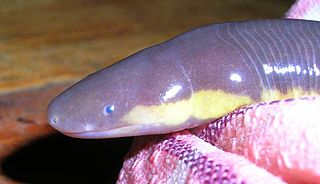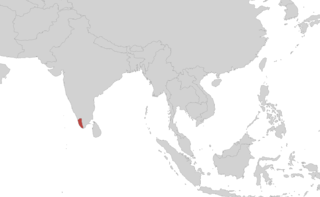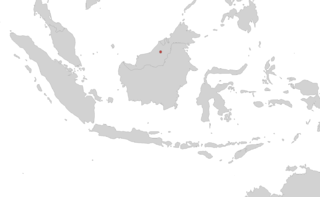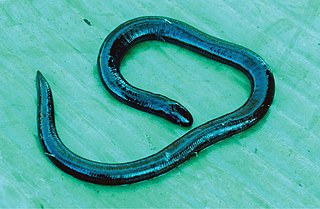
The Ichthyophiidae are the family of Asiatic tailed caecilians or fish caecilians found in South and Southeast Asia as well as southernmost China.

Ichthyophis is a genus of caecilians found in Southeast Asia, the southern Philippines, and the western Indo-Australian Archipelago.

Ichthyophis garoensis, the Garo Hills caecilian, is a species of caecilian found in Assam and Meghalaya in north-eastern India. The Husain's caecilian Ichthyophis husaini was until 2016 considered a separate species. It is a subterranean caecilian that lives in the moist leaf-litter of tropical forests. It is typically found close to streams and other waterbodies.

Ichthyophis tricolor, the three-colored caecilian or Maddatorai caecilian, is an amphibian endemic to the Western Ghats, India. Its taxonomic status is unclear, including its relationship with Ichthyophis beddomei and the possibility of cryptic species.

Ichthyophis pseudangularis is a species of caecilian endemic to Sri Lanka. It is found in a range of natural and man-made habitats: forests, rubber plantations, paddy fields, rural gardens and farms, wetlands, and pastureland.
Ichthyophis asplenius is a species of amphibian in the family Ichthyophiidae found in Malaysia and possibly Thailand. It is also known as broad-striped caecilian, Boven Mahakkam caecilian and Malayan caecilian. It is only known with certainty from Mahakam River and Matang Hunting Reserve Its natural habitats are subtropical or tropical moist lowland forests, rivers, intermittent rivers, plantations, rural gardens, heavily degraded former forest, irrigated land, and seasonally flooded agricultural land.
Ichthyophis paucidentulus, the Kapahiang caecilian, is a species of amphibian in the family Ichthyophiidae endemic to Indonesia. Its natural habitats are subtropical or tropical moist lowland forests, rivers, intermittent rivers, plantations, rural gardens, heavily degraded former forest, irrigated land, and seasonally flooded agricultural land.
Ichthyophis weberi, the Malatgan River caecilian, is a species of amphibian in the family Ichthyophiidae endemic to the Philippines. Its natural habitats are subtropical or tropical moist lowland forests, subtropical or tropical moist montane forests, rivers, intermittent rivers, plantations, rural gardens, heavily degraded former forests, irrigated land, and seasonally flooded agricultural land.
Ichthyophis atricollaris, also known as the Long Bloee caecilian, is a species of caecilian in the family Ichthyophiidae. It is endemic to Sarawak, Borneo (Malaysia), and only known from its imprecise type locality, "Long Bloee, Boven Mahakkam, Borneo". The type series were collected during the Nieuwenhuis expedition to Borneo and were deposited at the Rijksmuseum van Natuurlijke Historie, Leiden.
Ichthyophis biangularis, the angular caecilian or Metang caecilian, is a species of amphibian in the family Ichthyophiidae endemic to Borneo (Malaysia): it is only known from its type locality, Mount Matang in Sarawak, where the holotype was collected in 1872 by Alfred Hart Everett. New specimens were collected from the type locality only in 2009. In addition, one larval sample was collected from the same region and identified as likely Ichthyophis biangularis using genetic methods.

Ichthyophis billitonensis, the Billiton Island caecilian, is a species of amphibians in the family Ichthyophiidae endemic to the Belitung island, Indonesia. Known only from the holotype, this appears to be a small species, measuring 135 mm (5.3 in) in total length. Habitat requirements are unknown but it probably inhabits moist lowland forests. It may be threatened by habitat loss caused by opencast tin mining.

Ichthyophis dulitensis is a species of caecilian in the family Ichthyophiidae. It is endemic to Borneo and only known from near its type locality, Mount Dulit in northern Sarawak, Malaysia, after which it is named. Described by Edward Harrison Taylor in 1960, the holotype was collected by Charles Hose already in 1891. It is a poorly known species with uncertain taxonomic status. Common name Mount Dulit caecilian has been coined for it.

Ichthyophis elongatus, the elongated caecilian, is a species of amphibians in the family Ichthyophiidae endemic to Sumatra, including some nearby islands; however, whether these belong to this species is uncertain.

Ichthyophis glutinosus, the Ceylon caecilian or common yellow-banded caecilian, is a species of caecilian in the family Ichthyophiidae endemic to Sri Lanka. Its natural habitats are moist tropical and subtropical forests and pastures.

Ichthyophis hypocyaneus, the bantam caecilian, is a species of amphibian in the family Ichthyophiidae of caecilians, endemic to Indonesia. Until its rediscovery in 2000, it was known only from the 1827 type specimen.
The Upper Laos caecilian, Ichthyophis laosensis, is a species of amphibian in the family Ichthyophiidae. It is endemic to Laos and only known from a single specimen (holotype) collected from the imprecise type locality, "Upper Laos". Presumably a tropical moist forest species, nothing definite is known about its habitat or ecology.

Ichthyophis mindanaoensis, also known as Todaya caecilian or Mindanao Island caecilian, is a species of caecilian in the family Ichthyophiidae. It is endemic to the island of Mindanao, the Philippines.

Ichthyophis monochrous, the Western Borneo caecilian or black caecilian, is a species of amphibian in the family Ichthyophiidae. It is endemic to northern Borneo and known from western Kalimantan (Indonesia) and Sarawak (Malaysia), likely occurring also in Brunei. It is a little-known species known from only a few specimens. It presumably inhabits tropical moist forest. Adults are likely subterranean.
Ichthyophis singaporensis, the Singapore caecilian, is a species of amphibian in the family Ichthyophiidae endemic to Singapore. Its natural habitats are subtropical or tropical moist lowland forests, rivers, intermittent rivers, plantations, rural gardens, heavily degraded former forests, irrigated land, and seasonally flooded agricultural land.

Ichthyophis sumatranus, also known as the Sumatra caecilian, is a species of amphibian in the family Ichthyophiidae. It is endemic to Sumatra, Indonesia. It is known from western Sumatra, but many records lack precise location data and its exact range is poorly known.













